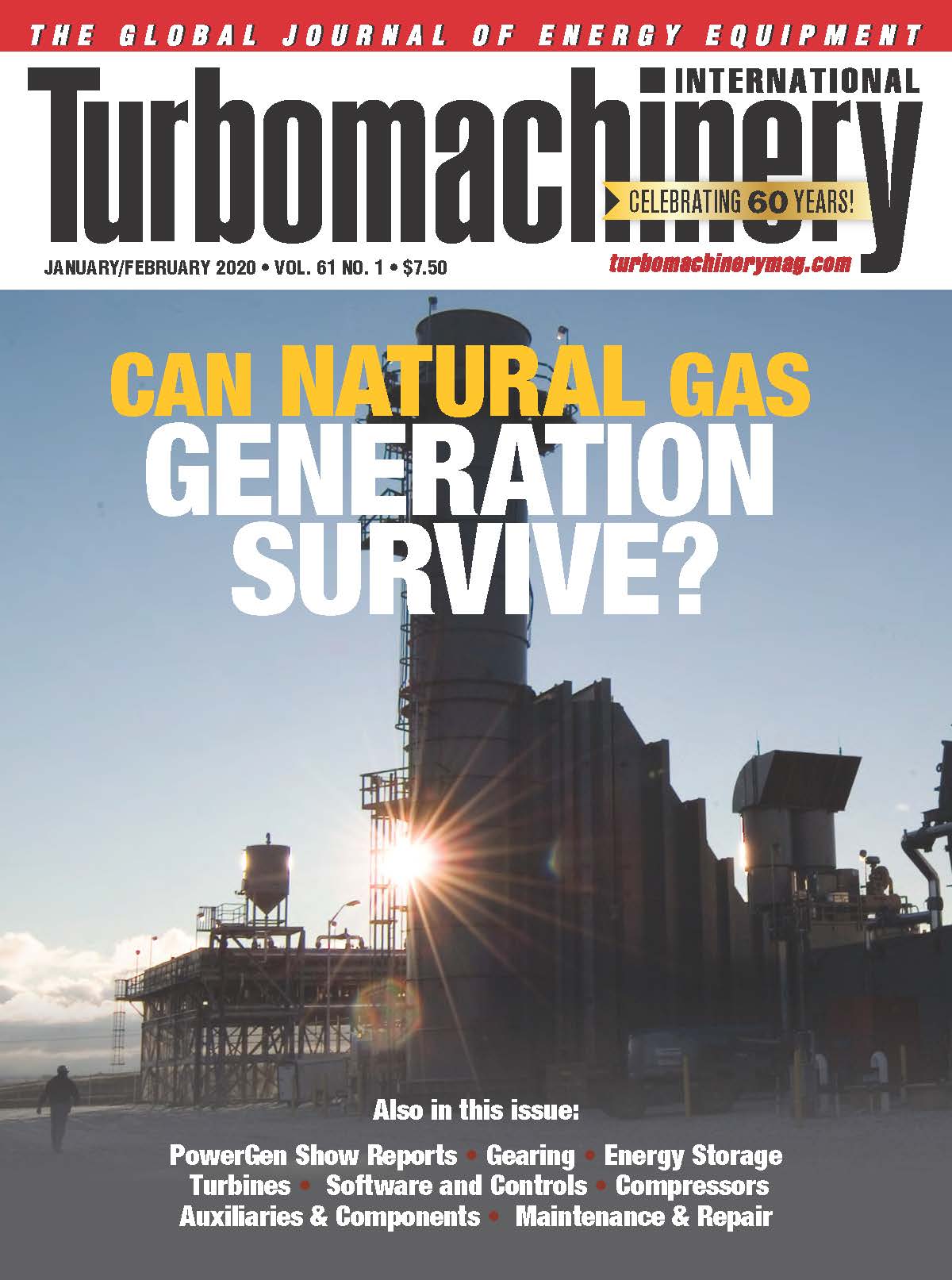PowerGen International

ENERGY STORAGE, HYDROGEN POWER, LUBRICATION AND CYCLING DOMINATE
by Drew Robb
PowerGen International remains the largest international event for the power industry. Held in New Orleans, LA in November 2019, one of the big changes from previous events was a focus on energy storage.
Battery technology is gobbling up market share that has traditionally been the province of gas turbine (GT) peakers. Batteries of 10 MW or more are now available. Analysts are predicting the likelihood of 10 GW battery farms by 2025. With costs declining below $300 per kW/h, the peaking industry is in for some tough competition.
Ihaab Chaban, Commercial Development Director at GE Aero, noted the benefits of batteries, such as instant response, zero emissions, no need for fuel, and short installation times. However, they struggle to operate reliably and do not offer the kind of ancillary services that GT’s provide, such as grid inertia and synchronous condensing.
Mitsubishi Hitachi Power Systems (MHPS) has already entered the battery business. The company reports many orders for its lithium ion products. It has also launched a photovoltaic ((PV) solar company to develop PV projects. Known as Oriden, it is currently focused on the Northeastern U.S.
MHPS chose Powergen to release its plans for a smaller version of an existing GT to better fit market needs. By converting the steam-cooled 330 MW J-class turbine to air-cooling and adding the latest technologies for combustion and fuel efficiency, the 425 MW JAC (60 Hz) has been upgraded to 340 MW at 64% efficiency.
This may be part of an overall trend toward smaller GTs. For decades, “bigger is better,” has been the operating rule as turbomachinery OEMs battled to release the largest machine at the highest efficiency. But medium-power GTs appear to be gaining momentum.
Lubrication
A partnership between GE and ExxonMobil was among the many other announcements at PowerGen. Mobil SHC 918 EE GT oil is tailored toward multi-shaft GTs, such as the GE 7HA, GE 9HA, GE 6FA.01 and the GE 7FA.
Both companies are touting the value of this new lubricant, claiming improved reliability as well as a jump in turbine bearing efficiency of as much as 15% compared with traditional oils.
Not to be outdone, Shell Lubricants has released a gas-to-liquid (GTL) base oil aimed at lengthening GT life and minimizing the formation of varnish. The GTL base oil is produced by partially oxidizing natural gas to produce a syngas (a mix of carbon monoxide and hydrogen). A catalyst is used to convert the syngas into liquid hydrocarbons before cracking separates these into diesel, kerosene and lubricants.
Hydrogen push
Hydrogen power continued to generate attention at PowerGen. Ansaldo Energia is working with Dow Chemical to harness hydrogen remaining from Dow processes for power generation by mixing it with natural gas. Other approaches include electrolysis of water to produce hydrogen, powered by renewable energy. This is known as green hydrogen.
MAN Energy Solutions is another company investing in hydrogen. It has acquired a 40% share in H-Tec Systems, which specializes in electrolysis technology. H-Tec develops and produces stacks and electrolyzers for manufacturing hydrogen with electricity. Water electrolysis and other such techniques, they predict, will eventually lead to an affordable source of hydrogen on a large scale.
Cycling
Base loaded units run at or near full load for an extended period. They are warmed to their operating temperature slowly via restricted ramp rates. They come offline only for maintenance and otherwise run continuously.
Cycling units, on the other hand, experience varied loads, ramp up rapidly and experience frequent starts and stops. With far greater presence of renewables on the grid, cycling has become commonplace. But there are consequences.
Daniel Azukas, Senior Management Consultant at Sargent & Lundy summarized the negative impact of cycling. Thick-walled components face increased thermal stresses. Rapid startup times are stressful for the steam turbine (ST) as it is typically the slowest part of the power generation system to warm up.
As a result, there is increased use of drains and vents, and more frequent condensate generation upon shutdown. If not cleared before the next start, this can be damaging.
To make a plant more capable of handling cycling, Aukas made several recommendations:
• Maintain heat in the unit during shutdown
• Steam sparging
• Maintain a vacuum during shutdown
• Keep the ST warm
• Start the combustion turbine and ramp it up independently of the ST
• Ensure the drain system is adequate.
Water chemistry upsets can affect fluid assisted corrosion (FAC) and ID corrosion. Appropriate water chemistry control should be instituted to deal with cycling demand, along with an FAC inspection program.
Cycling has a significant impact on the bottoming cycle, said Azukas. More output from an existing combustion turbine has consequence for the bottoming cycle. More exhaust gas flow, higher temperatures, a changing exhaust gas flow profile, more steam production, higher steam temperatures, and duct firing for supplemental fired units should be considered.
Additionally, the balance of plant would need to be able to handle higher heat loads and more steam condensing. Similarly, the auxiliary cooling system should be beefed up to handle increased heat load from equipment.
